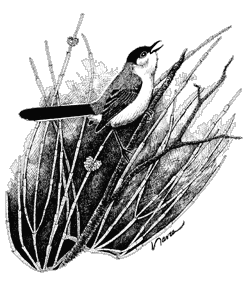Black-tailed Gnatcatcher
Gnatcatchers are diminutive birds that hop and flit among foliage, flipping their long tails about in an expressive way, as they seek tiny insects. While the related Blue-gray Gnatcatcher may appear along southwestern U.S. rivers in winter, Black-tailed Gnatcatchers are true desert birds. They thrive in typical Sonoran Desert, with its relatively rich vegetation, and they also can be found on open creosote bush flats where other bird life is sparse.

Living in pairs at all seasons, the male and female Black-tailed Gnatcatchers usually forage within a few yards of each other. Perhaps this togetherness gives them a heightened need to communicate—they have a surprising variety of callnotes. They will come in close to investigate imitations of those calls, but they also seem to do some imitating of their own: some of their notes sound very much like Black-throated Sparrows and Verdins.
This Gnatcatcher and the Verdin are the two smallest resident songbirds in the desert. The two species are not related, and should not be in direct competition most of the time, but they interact at times—foraging together, or chasing each other about. This is especially true of young birds, who may be simply picking on someone their own size.
—Kenn KaufmanBlack-tailed Gnatcatcher (Polioptila melanura)
Order: Passeriformes
Family: Sylviidae
Spanish names: pisita colinegra, perlita colinegra
Description
This tiny bird measures 4¼ to 5 inches (11 to 13 cm). It is gray above and whitish below. The male has a black cap during the summer that extends to the eyes. The long tail is black with white corners. Females and winter males, lacking the black cap, are difficult to distinguish from the Blue-gray Gnatcatcher. The best way to tell the two apart is the tail: that of the blue-gray is mostly white as viewed from below; the black-tailed is predominantly black underneath.
Range
The Black-tailed Gnatcatcher is a permanent resident from southeastern California and Arizona east to southern Texas and south into Mexico.
Habitat
It is found in desert brush, dry washes, and mesquite bosques.
Life History
Black-tailed Gnatcatchers live in pairs all year, defending their territory and foraging in trees and low shrubs for a wide variety of small insects and some spiders. Unlike the Blue-gray Gnatcatcher, which it closely resembles, the Black-tailed Gnatcatcher rarely catches insects in midair.
The open cup nest, which is typically found in a low shrub less than 5 feet above the ground, is built by both sexes. It is constructed of a variety of materials including weeds, grass, strips of bark, spider webs and plant fibers; it is lined with finer, softer matter. Three to 5 bluish-white eggs with red-brown dots are incubated by both parents and take 14 days to hatch. Both parents feed the young, which leave the nest 10 to 15 days after hatching. Even though cowbirds often lay eggs in this species’ nests, and the pair end up raising cowbird young, the Black-tailed Gnatcatcher populations seem to be holding up well.
Migration
The two most significant events in the annual cycle of a bird are nesting and feather molting. In some species there is a third equally important event, migration. Migrations are generally long- distance movements made by populations of birds. They typically involve movement into or out of highly seasonal environments. The reasons for migration revolve around exploiting seasonally abundant resources and/or avoiding environments with seasonally rare resources. Yellow warblers breed in our desert riparian habitats where during the summer there is an abundance of insects. For the winter they move back to tropical America. Many grassland sparrows of the northern Great Plains winter in our desert grasslands, while their grassland home is covered in snow. Our resident American kestrel population is augmented in the winter by individuals from more northern populations. And of course there are residents that never migrate, such as the Cactus Wren, Roadrunner, and Black-tailed Gnatcatcher. There are many patterns to migration, differing from species to species.










